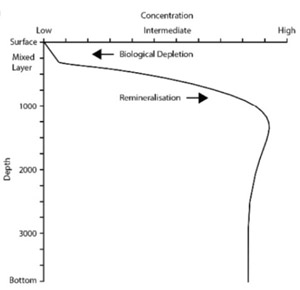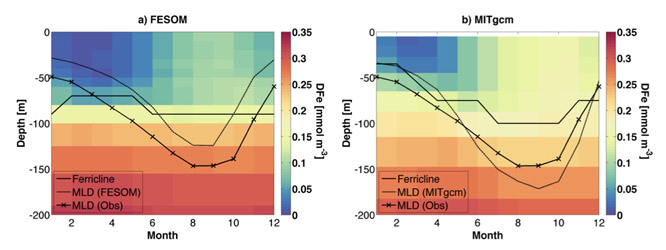E. OIF by Artificial Upwelling in Southern Ocean
••••••All 13 artificial iron experiments have confirmed that the iron supply limits primary production and has impact on phytoplankton species composition and bloom dynamics in tropical as well as in polar HNLC waters (Boyd et al., 2007).
••••••de Baar et al (1995) tested the iron hypothesis by looking at natural levels of phytoplankton productivity in regions of the Southern Ocean with differing iron abundance. The southerly branch of the Antarctic Circumpolar Current (ACC) results in upwelling of deep waters and supplies sufficient iron to the surface to sustain moderate primary production but not to permit blooms to develop. In contrast, within the fast-flowing, iron-rich jet of the polar front (PF), spring blooms produced phytoplankton biomass an order of magnitude greater than that in southern ACC waters, leading to CO2 undersaturation. The plankton-rich PF waters were sharply delineated from adjacent iron-poor waters, indicating that iron availability was the critical factor in allowing blooms to occur.
••••••Between 2004 and 2005 the first planned natural iron fertilization experiment in the Southern Ocean, took place (Breitbart, E. et al (2010). It was termed CROZEX for the CROZet natural iron bloom and EXport experiment. The CROZet bloom which occurs annually north of the Crozet Islands and Plateau and is caused by upwelling, was surveyed by Pollard et al, (2007). This showed that the efficiency of natural fertilization was at least 10 to 20 times greater than that of a phytoplankton bloom induced artificially by adding iron.
••••••Blain et al (2007) described a second similar study the KEOPS (Kerguelen ocean and plateau compared study) carried out between January 19 to February 13, 2005. They also reported observations of a phytoplankton bloom induced by natural iron fertilization due to upwelling. These studies offered an opportunity to overcome some of the limitations of short-term artificial Fe fertilization experiments. They found that a large phytoplankton bloom over the Kerguelen plateau in the Southern Ocean was sustained by the supply of iron and major nutrients to surface waters from iron-rich deep water below. The efficiency of fertilization, defined as the ratio of the carbon export to the amount of iron supplied, was at least ten times higher than previous estimates from short-term blooms induced by artificial iron-addition experiments. At the center of the bloom the partial pressure of CO2 dropped from 390 to 310 uatm.
••••••The specific results are as follows. The artificial experiments indicated an efficiency of biological carbon export into deeper water (100–250 m) ranging from 650 (SERIES, Boyd et al., 2004) to 3,300 (mol C/mol Fe) (SOFEX – south, Buesseler et al., 2004). The seasonal sequestration efficiencies estimated for natural Fe fertilization are much higher, 8,640 for CROZEX (Pollard et al., 2009) and 154,000 for KEOPS (Chever et al., 2010).
••••••The discrepancies in effectiveness between natural and purposeful fertilizations might be partly due to the ∼75% immediate loss of added Fe in artificial fertilizations (de Baar et al., 2008).
••••••This superiority of natural iron sources over artificial ones suggests that:
••••••a) that simulation of natural fertilization by the use of airborne aerosols of biogenic iron, as outlined in proposal #3, might also be much more efficient than ship-based iron fertilization, and
••••••b) that simulation of natural upwelling fertilization by the use artificial upwelling, might be much more productive than artificial ship based OIF.
••••••In a Chinese study by YiWen et al (2016) it was shown that cold and hypoxic deep ocean water (DOW) could be uplifted to the euphotic layer, which could potentially change the nutrient distribution and adjust the N/P ratio. Zhejiang University has overcome the technical challenges in designing and fabricating a robust and high efficiency artificial upwelling device which has been examined in two field experiments. Both simulation and field experiments results confirmed that utilizing self-powered energy to inject compressed air to uplift DOW was a valid and efficient method. They concluded that further field-based research on artificial upwelling, especially for long-term field research, is required to test the scientific hypothesis.
••••••The following are two graphs showing the distribution of sub-surface iron in the Southern Ocean.
••••••••••••


••••••This indicates that the upwelling pipes should reach from 200m to 1,200m below the surface.
••••••We propose that the Comings Foundation cooperate with the Chinese, or other comparable groups, to fund upwelling studies as applied to the Southern Ocean.
For more details see www.TheComingsFoundation -> 3. Role of the Ocean in Climate Change -> III. Geoengineering Microalgae.
YiWen, P. et al (2016) Research progress in artificial upwelling and its potential environmental effects. Science China Earth Sciences 59 (2):236–248.

